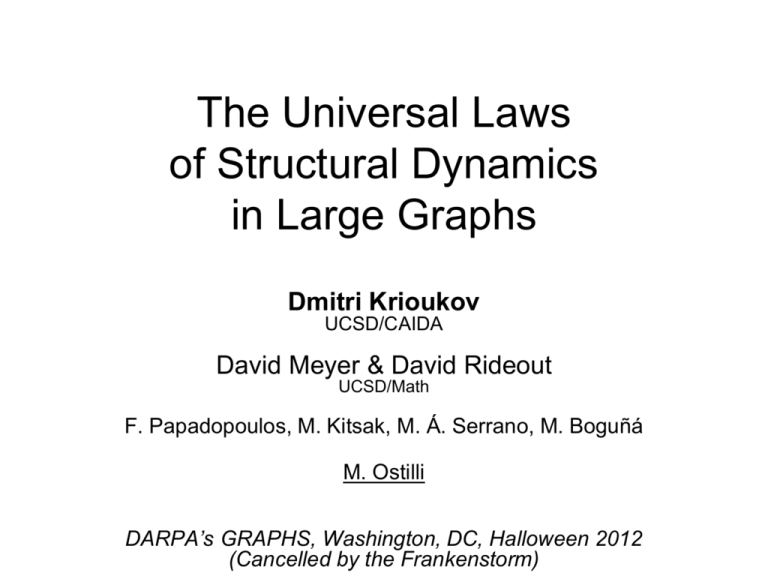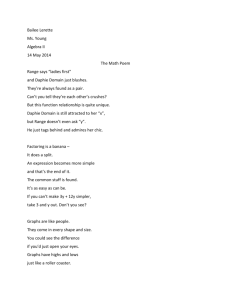Powerpoint
advertisement

The Universal Laws of Structural Dynamics in Large Graphs Dmitri Krioukov UCSD/CAIDA David Meyer & David Rideout UCSD/Math F. Papadopoulos, M. Kitsak, M. Á. Serrano, M. Boguñá M. Ostilli DARPA’s GRAPHS, Washington, DC, Halloween 2012 (Cancelled by the Frankenstorm) High-level project description • Motivation: – Predict network dynamics – Detect anomalies • Goal: – Identify the universal laws of network dynamics • Methods: geometry: random geometric graphs – Past work: static graphs – Present/future work: dynamic graphs Outline • Hyperbolic popular similar – Growing random hyperbolic graphs • Next step – Random Lorentzian graphs Growing hyperbolic Random geometric graph • “Discretization” of a smooth manifolds (B.Riemann, Nature, v.7) hyperbolic • Take a circle of radius R R grows to R+dR 1 new point in [R,R+dR] • Sprinkle N points into it uniformly at random new point to existing • Connect each pair of points iff the distance between them is x r R 𝑡 = 1,2,3, … 𝑟𝑡 = ln(𝑡) 𝜃𝑡 ∈ 𝑈(0,2𝜋) Connecting to m closest nodes The expected distance to the m’th closest node from t is: 𝜋𝑚𝑡 𝜋𝑚 𝑅𝑡 = ln ≈ 𝑟𝑡 + ln ≈ 𝑟𝑡 1 2 2 1− 𝑡 New node t located at radial coordinate rt ln t, and connecting to all nodes within distance Rt ~ rt, connects to a fixed number of closest nodes Closest nodes The hyperbolic distance between s and t is 𝑥𝑠𝑡 = acosh cosh 𝑟𝑠 cosh 𝑟𝑡 − sinh 𝑟𝑠 sinh 𝑟𝑡 cos 𝜃𝑠𝑡 𝜃𝑠𝑡 𝑠𝑡𝜃𝑠𝑡 ≈ 𝑟𝑠 + 𝑟𝑡 + ln = ln 2 2 Find m nodes s, s t, with smallest xst for a given t: 𝑠𝑡𝜃𝑠𝑡 𝑠𝑡𝜃𝑠𝑡 min 𝑥𝑠𝑡 = min ln = min = min 𝑠𝜃𝑠𝑡 2 2 New node t connects to a fixed number of existing nodes s with smallest s st Hyperbolic popular similar • Two dimensions of attractiveness – Radial popularity: birth time s: • The smaller the s, the more popular is the node s – Angular similarity: distance • The smaller the st, st: the more similar is the node s to t • New node t connects to existing nodes s optimizing trade-offs between popularity and similarity • This trade-off optimization yields hyperbolic geometry What else it yields • Power-law graphs • With strongest possible clustering • Effective preferential attachment 𝑟𝑠 𝑡 = 𝛽𝑟𝑠 + (1 − 𝛽)𝑟𝑡 𝑠<𝑡 0<𝛽≤1 1 𝛾 =1+ 𝛽 𝑃 𝑘 ~ 𝑘 −𝛾 Clustering • Probability of new connections from t to s so far 𝑝 𝑥𝑠𝑡 = Θ 𝑅𝑡 − 𝑥𝑠𝑡 • If we smoothen the threshold 1 𝑝 𝑥𝑠𝑡 = 1+ 𝑥𝑠𝑡 −𝑅𝑡 𝑒 𝑇 T→0 Θ 𝑅𝑡 − 𝑥𝑠𝑡 • Then average clustering linearly decreases with T from maximum at T = 0 to zero at T = 1 • Clustering is always zero at T > 1 • The model becomes identical to PA at T Effective preferential attachment • Average attractiveness of nodes of degree k is a linear function of k • Probability that new node t connects to 𝑘−𝑚 an existing node of degree k is Π 𝑘 = 𝑡 PSO • PSO PA PA S, where – PSO is popularity similarity optimization – PA is preferential attachment (popularity) – S is similarity (sphere) • PA is 1-dimensional (radial popularity) • PSO is d 1-dimensional, where d is the dimensionality of the similarity space Validation • Take a series of historical snapshots of a real network • Infer angular/similarity coordinates for each node • Test if the probability of new connections follows the model theoretical prediction Learning similarity coordinates • Take a historical snapshot of a real network • Apply a maximum-likelihood estimation method (e.g., MCMC) using the static hyperbolic model • Metropolis-Hastings example – – – – – – – – Assign random coordinates to all nodes aij 1 aij Compute current likelihood Lc p ( xij ) [1 p ( xij )] i j Select a random node Move it to a new random angular coordinate Compute new likelihood Ln If Ln > Lc, accept the move If not, accept it with probability Ln / Lc Repeat Real networks • PGP web of trust – Nodes: PGP certificates (roughly, people) – Links: Trust relationships • Internet – Nodes: Autonomous systems (ASes) – Links: Business relationships • Metabolic (E.coli) – Nodes: Metabolites – Links: Reactions Binning and overfitting • Number of parameters (𝑂(𝑁), node coordinates) is much smaller then the number of unknowns (𝑂(𝑁 2 ), distances between nodes) • Overfitting is impossible but we have to bin the hyperbolic distances with a small number of bins to compute empirical connection probability • More rigorous measures of the fitting quality, independent of any binning, are desired More rigorous measures of modeling quality • By maximizing likelihood ℒ, MLE minimizes the logarithmic loss 𝐿 ≡ − log ℒ • The modeling quality is thus measured by either the log-loss difference 𝐿 − 𝐿𝑟𝑎𝑛𝑑 , or the normalized ℒ likelihood = exp(𝐿𝑟𝑎𝑛𝑑 − 𝐿), where ℒ𝑟𝑎𝑛𝑑 – 𝐿 is the log-loss with the inferred coordinates – 𝐿𝑟𝑎𝑛𝑑 is the log-loss with random angular coordinates • The normalized likelihood ℒ/ℒ𝑟𝑎𝑛𝑑 is thus the ratio of the probability that a given network with the inferred coordinates is generated by the model, to the same probability with random coordinates, in which case the network has “nothing to do” with the model Normalized likelihood Network ℒ/ℒ𝒓𝒂𝒏𝒅 Social web of trust (PGP) exp(2.3 × 105 ) Internet (AS) exp(1.3 × 105 ) Metabolic (E.Coli) exp(6.7 × 103 ) Actor collaborations (IMDB) exp(−2.2 × 106 ) • The popularity similarity model does not describe well the actor network because very dissimilar actors often collaborate on big movies Soft community detection effect • Inferred coordinates correlate with meaningful node groups Capturing network structure • As a “simple” consequence of the fact the PSO model accurately describes the large-scale network growth dynamics, it also reproduces very well the observed large-scale network structure across a wide range of structural properties Take-home messages (on PSO) • Popularity similarity optimization dynamics Geometrical hyperbolicity Topological heterogeneity transitivity (real nets) • Popularity is modeled by radial coordinates • Similarity is modeled by angular coordinates – Projections of a properly weighted combination of all the factors shaping the network structure Immediate applications (submitted) • New simple network-embedding method – The idea is to “replay” the growth of a given network snapshot according to PSO • New link prediction method, outperforming all the most popular link prediction methods – Some classes of links can be predicted with 100% accuracy – Perhaps because the method captures all the factors shaping the network structure Something is definitely wrong • Node density is not uniform unless 𝛾 = 3, while 𝛾 ≈ 2 in all the considered real networks • Modeled graphs are not random geometric graphs • They do not properly reflect hyperbolic geometry • The main project goal (find fundamental laws of network dynamics using geometry) cannot be achieved using hyperbolic geometry Plausible solution • Geometry under real networks is not hyperbolic but Lorentzian • Lorentzian manifolds explicitly model time • Proof that PSO graphs are random geometric graphs on de Sitter spacetime (accepted) Lorentzian manifolds • Pseudo-Riemannian manifold is a manifold with a non-degenerate metric tensor – Distances can be positive, zero, or negative • Lorentzian manifold is a manifold with signature (−, +, +, … , +) – Coordinate corresponding to the minus sign is called time – Negative distance are time-like – Positive distance are space-like Causal structure • For each point 𝑝 ∈ 𝑀, the set of points at timelike distances from p can be split in two subsets: – 𝐼+ 𝑝 = p’s future – 𝐼− 𝑝 = p’s past • If 𝑞 ∈ 𝐼 + (𝑝), then 𝐴 𝑝, 𝑞 = 𝐼+ (𝑝) ∩ 𝐼 − (𝑞) is called the Alexandrov set of (𝑝, 𝑞) Alexandrov sets • Form a base of the manifold topology – Similar to open balls in Riemannian case Lorentzian Random geometric graph • “Discretization” of a smooth manifolds (B.Riemann, Nature, v.7) Lorentzian T; 𝑡 ∈ [0, 𝑇] • Take a circle of radius R • Sprinkle N points into it uniformly at random • Connect each pair of points iff the distance between them is x r R 0; because Alexandrov sets are “balls” now Major challenge (in progress) • On the one hand, random Lorentzian graphs are random geometric graphs, and consequently exponential random graphs (equilibrium ensembles) • On the other hand, they are dynamic growing graphs (non-equilibrium ensembles) • Can it be the case that a given ensemble of graphs is static (equilibrium) and dynamic (non-equilibrium) at the same time??? • If we prove that it is indeed the case, then we – Discover some unseen static-dynamic graph duality – Open a possibility to apply very powerful tools developed for equilibrium systems (e.g., exponential random graphs), to dynamic networks • F. Papadopoulos, M. Kitsak, M. Á. Serrano, M. Boguñá, and D. Krioukov, Popularity versus Similarity in Growing Networks, Nature, v.489, p.537, 2012





